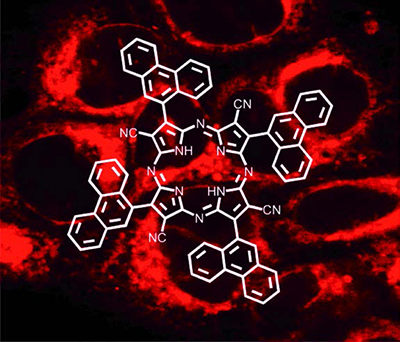Журнал "Макрогетероциклы"
Navigation
News
Impact Factor 2021 = 1.200 has been issued by ISI Web of Knowledge (JCR 2021).
Search
ISSN 1998-9539
Cyano-Aryl Porphyrazine Pigments with Polycyclic Substituents as the Promising Agents for Photodynamic Therapy and Potential Sensors of Local Viscosity
Svetlana A. Lermontova,a Ilya S. Grigoryev,a Nina N. Peskova,b Elena Yu. Ladilina,a Tatyana S. Lyubova,a Vladimir I. Plekhanov,c Ivan D. Grishin,b Irina V. Balalaeva,b and Larisa G. Klapshinaa,b@
Dedicated to Professor Dieter Wöhrle on the occasion of his 80th Anniversary
aG.A. Razuvaev Institute of Organometallic Chemistry of RAS, 603950 Nizhny Novgorod, Russia
bN.I. Lobachevsky State University of Nizhny Novgorod, 603950 Nizhny Novgorod, Russia
cInstitute of Applied Physics of RAS, 603950 Nizhny Novgorod, Russia
@Corresponding author E-mail: klarisa@iomc.ras.ru
DOI: 10.6060/mhc190865k
Macroheterocycles 2019 12(3) 268-275
The unique cyanoporphyrazine pigment with four bulky phenanthrenyl peripheral substituents has been prepared. It demonstrates the noticeable shift of Q-band to longer wavelengths due to phenanthryl aromatic system extension. The compound showed very strong predominance of photoinduced cytotoxicity over cytotoxicity in the dark. The presented results indicate the enhancement of photodynamic properties of porphyrazine containing polycyclic aryl substituents in peripheral framing. It is confirmed that the chemical design of the peripheral aryl groups is an efficient toolkit for a fine tuning of photodynamic properties. Furthermore, we have shown that in spite of the presence of bulky substituents new cyano-aryl porphyrazine demonstrates the properties of fluorescent molecular rotors, i.e. the segmental intramolecular mobility in environment of low viscosity. Previously on the example of related cyano-aryl porphyrazines combining the properties of fluorescent molecular rotors and photosensitizers we have demonstrated high potential of these compounds as the sensors of local viscosity and rigidity of biological submicrometer environment within a living cell. So, in respect to PDT it can be a significant expansion of photosensitizer functionality as a potential agent of optical theranostics.

| Attachment | Size |
|---|---|
| mhc190865k.pdf | 2.55 MB |
- 1706 reads
- Русский
